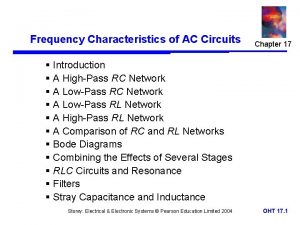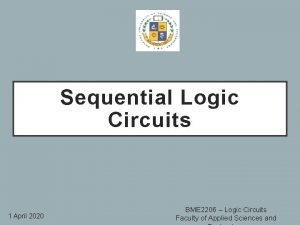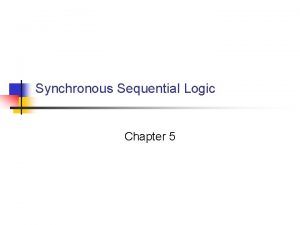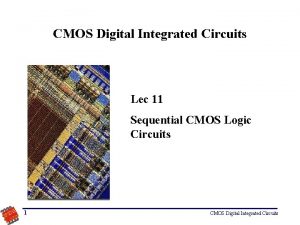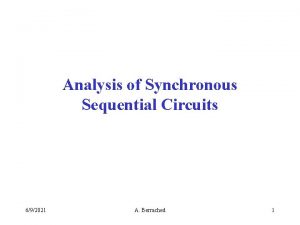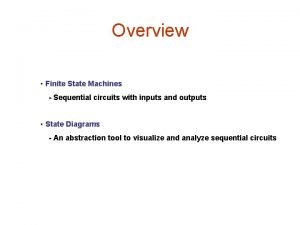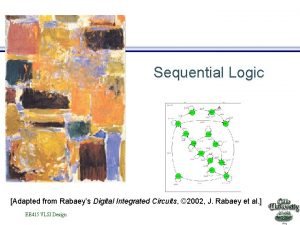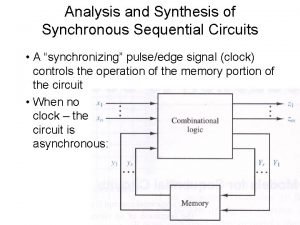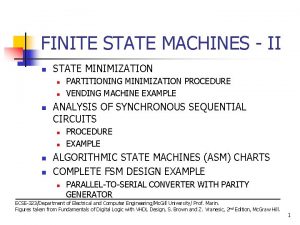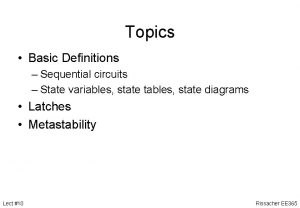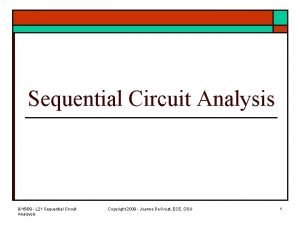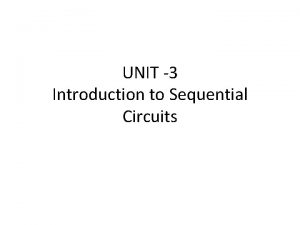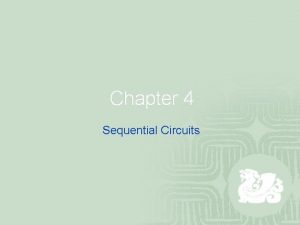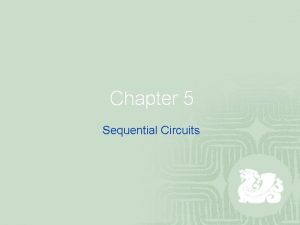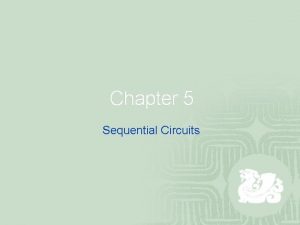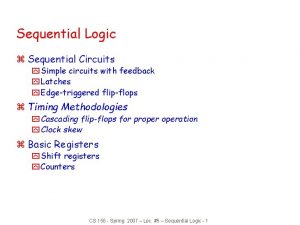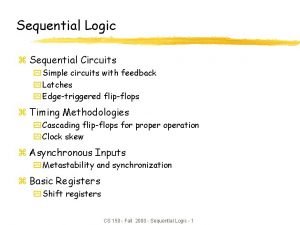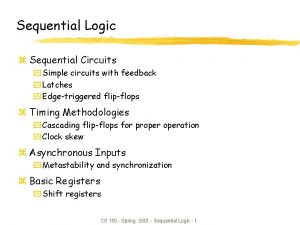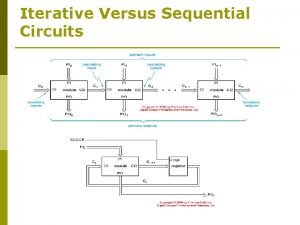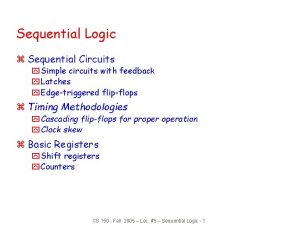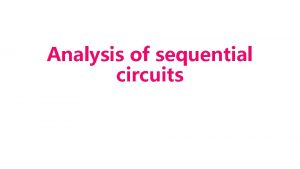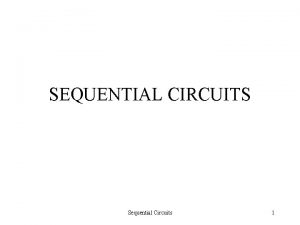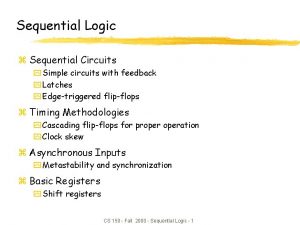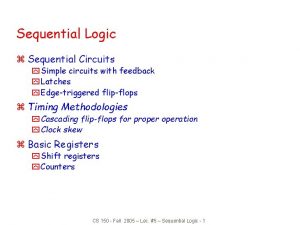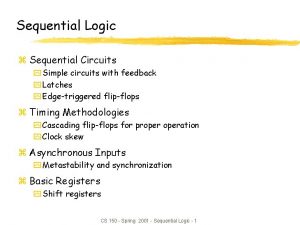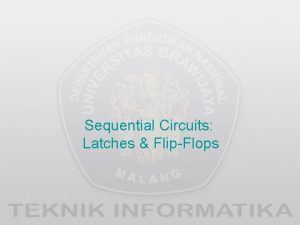Sequential Circuits Sequential Circuits In the previous session


















- Slides: 18

Sequential Circuits

Sequential Circuits § In the previous session, we said that the output of a combinational circuit depends solely upon the input. § The implication is that combinational circuits have no memory. In order to build sophisticated digital logic circuits, including computers, we need more a powerful model. § We need circuits whose output depends upon both the input of the circuit and its previous state. In other words, we need circuits that have memory.

Sequential Circuits § For a device to serve as a memory, it must have three characteristics: • the device must have two stable states • there must be a way to read the state of the device • there must be a way to set the state at least once.

Latches and Flip Flop § In the same way that gates are the building blocks of combinatorial circuits, latches and flip-flops are the building blocks of sequential circuits. § While gates had to be built directly from transistors, latches can be built from gates, and flip-flops can be built from latches. This fact will make it somewhat easier to understand latches and flip-flops.

Latches and Flip Flop § Both latches and flip-flops are circuit elements whose output depends not only on the current inputs, but also on previous inputs and outputs. The difference between a latch and a flip-flop is that a latch does not have a clock signal, whereas a flip-flop always does. § Common examples of latches: • S-R latch, D latch (= gated D latch) § Common examples of flip-flops (FF): • D-FF, D-FF with enable, Scan-FF, JK-FF, T-FF

S-R Latch § Circuit Design Using NOR gates § Function Table: hold, no change Reset Set not allowed, unstable (Q=QN)

S-R latch Function table:

Clocked (NOR) S-R Latch • Clk=0: input has no effect: latch is always in “hold” mode (retain its previous state) • Clk=1: latch is a regular S-R latch

D latch Function table:

Flip-Flop § Latches a re a synchronous, which means that the output changes very soon after the input changes. Most computers today, on the other hand, are synchronous, which means that the outputs of all the sequential circuits change simultaneously to the rhythm of a global clock signal. § A flip-flop is a synchronous version of the latch.

Flip-Flop § A flip-flop circuit can be constructed from two NAND gates or two NOR gates. Each flip-flop has two outputs, Q and Q′, and two inputs, set and reset. This type of flip-flop is referred to as an SR flip-flop or SR latch. The flip-flop in has two useful states. When Q=1 and Q′=0, it is in the set state (or 1 -state). When Q =0 an d Q′=1, it is in the clear state (or 0 -state).

Flip-Flop § The outputs Q and Q′ are complements of each other and are referred to as the normal and complement outputs, respectively. The binary state of the flip-flop is taken to be the value of the normal output.

D Flip-Flop § If D input is 1, the flip-flop is switched to the set state (unless it was already set). If it is 0, the flip-flop switches to the clear state.

J-K Flip-flop § Behavior of JK flip-flop: • Same as S-R flip-flop with J analogous to S and K analogous to R • Except that J = K = 1 is allowed, and • For J = K = 1, the flip-flop changes to the opposite state (toggle) § Behavior described by the characteristic table (function table): J Q C K J 0 0 1 1 K Q(t+1) 0 Q(t) no change 1 0 reset 0 1 set 1 Q(t) toggle

T Flip-flop § Behavior described T by its characteristic 0 1 table: Q(t+1) Q(t) no change Q(t) complement • Has a single input T § For T = 0, no change Characteristic equation: Q(t+1)=T’Q(t) + TQ’(t) to state = T Q(t) § For T = 1, changes to opposite state T C

Flip-Flop Characteristic Tables D Q Q J Q K Q T Q Q D 0 1 J 0 0 1 1 T 0 1 Q(t+1) 0 1 Reset Set K Q(t+1) 0 Q(t) 1 0 0 1 1 Q’(t) No change Reset Set Toggle Q(t+1) Q(t) Q’(t) No change Toggle

Flip-Flop Characteristic Equations D Q Q J Q K Q T Q Q D 0 1 J 0 0 1 1 Q(t+1) 0 1 K Q(t+1) 0 Q(t) 1 0 0 1 1 Q’(t) T 0 1 Q(t+1) Q(t) Q’(t) Q(t+1) = D Q(t+1) = JQ’ + K’Q Q(t+1) = T Q

Characteristics Equation § Specify next state as a function of its current state and inputs § Q(t) current state § Q(t+1) next state § For example: § SR latch: Q(t+1) = S + R’Q(t) § D flip-flop: Q(t+1) = D § JK flip-flop: Q(t+1) = JQ’(t)+K’Q(t) § T flip-flop: Q(t+1) = T⊕Q(t)= TQ’(t)+T’Q(t)
 Solved: ph dincussion ac circuits session 12 q2. low-pass
Solved: ph dincussion ac circuits session 12 q2. low-pass Sequential circuits
Sequential circuits Synchronous sequential circuits examples
Synchronous sequential circuits examples Digital circuits
Digital circuits Mealy or moore machine
Mealy or moore machine Non bistable sequential circuits
Non bistable sequential circuits Analysis of synchronous sequential circuits
Analysis of synchronous sequential circuits Finite state machine sequential circuits
Finite state machine sequential circuits Sequential circuits prelude
Sequential circuits prelude Non bistable sequential circuits
Non bistable sequential circuits State diagram
State diagram Finite
Finite Sequential circuits
Sequential circuits Analysis of sequential circuits
Analysis of sequential circuits Introduction to sequential circuits
Introduction to sequential circuits Analysis of sequential circuits
Analysis of sequential circuits Advantages of parallel circuits over series circuit
Advantages of parallel circuits over series circuit Các châu lục và đại dương trên thế giới
Các châu lục và đại dương trên thế giới Mật thư anh em như thể tay chân
Mật thư anh em như thể tay chân
